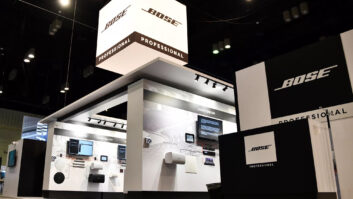It’s easy to get jaded about microphones today. You can’t swing a
dead cat without hitting another new condenser mic. And the constant din of “just as
good as” in the marketplace is loud enough to rattle the fillings in
your tightly clenched teeth. However, poke your head above the clamor,
and the mic population thins out. That’s where you’ll find mics like
the Brauner Valvet.
UNDER THE HOOD
A dual-pattern (cardioid/omni) tube mic, Valvet is priced at $2,695 with
suspension, power supply, cable and metal roadcase. Removing three
Allen-head screws that lock the outer housing to the internal chassis,
I looked inside. The German-made Valvet has a dual, large-diaphragm,
pressure gradient condenser capsule featuring a Siemens EF 86 vacuum
tube and an LL1577 Lundahl output transformer. The hard plastic base of
the capsule is disc-shaped, with a hemispherical nipple. A
crescent-shaped cradle attached to the top appears to help provide
shock isolation for the metal capsule.
Each backplate of the capsule has 108 holes drilled into it. Those
and the ten through-holes are plainly visible because the gold-coated
membranes are extremely thin. Construction quality inside the mic is
solid and clean. The printed circuit card in the body of the mic has
perhaps the fewest components I’ve seen.
The circular headgrille has a flat open top and uses a double mesh
metal grille that is very open in appearance. The custom mic suspension
uses six elastic bands and an inner semicircular cradle that the mic
snugs into. The connection between the mic and the cradle looks a bit
disconcerting, but the cradle holds the mic quite firmly and at the
same time allows it to be rotated for positioning. A lever on the
suspension-mount pipe thread allows the mic to be tilted and then
locked into place.
The separate power supply has three toggle switches: one changes the
pattern from cardioid to omni. Another flips the polarity of the
signal, and a third turns the supply on and off. A trendy blue LED
indicates power. on the back side are connections for the multipin
cable to the mic, a mic level output and a standard IEC power jack. All
power is provided by this power supply, so phantom power is not required. Brauner lists the
specs in a minimalist manual. Self-noise is 13 dBA, in omni or
cardioid. Signal-to-noise is 81 dBA in cardioid, and sensitivity is 28
mV/Pa. Frequency response is listed as 40 to 22k Hz, -3 dB. Maximum SPL is 142 dB (0.3% THD). The manual
notes directivity as omni and figure-eight, which is perhaps a
cut-and-paste error from another model, as the Valvet is cardioid and
omni. Switching between patterns with the Valvet merely creates several
gentle, low-level “whumps.”
THE SOUND
If I were to write a two-word review of Valvet, it would say: “Instant
Airband.” Although it’s a tube mic, the Valvet isn’t the sort of tube
mic that gives that slow, soft, smokey sound. This is the mic to use to
get that intimate, down-the-throat R&B ballad vocal. If the
vocalist has polyps, you’ll be able to count them. Make sure your
vocalist doesn’t have any mouth noise problems. Valvet will not ignore
them.
I had a first fling with the Valvet at Flite Three in Baltimore.
Going through their API console, the brightened Valvet, combined with
the API edge, was very unflattering on male vocals. Acoustic
fingerpicked guitar, on the other hand, sounded quite nice. This
experience again emphasizes the importance of matching the right mic
with the right preamp for the specific job. My guess would be that the
Valvet, given its high-profile personality, would be better matched
with more neutral preamps like the Millennia Media and Benchmark.
Back at my studio, I set up a Neumann TLM103 side by side with the
Valvet in cardioid and, using a pair of GML mic pre’s, ran to left and
right inputs of my orban Audicy workstation. The GML are recognized to
be mostly neutral. Positioning myself between the mics and trimming the
Valvet back a few dB to match the TLM103, I recorded a piece of
narration. on playback I was surprised to find that, although the
Valvet track was brighter, the difference wasn’t as great as I had
expected. The Valvet wouldn’t be my choice for V/o work with a sibilant
voice, nor would I grab it to beef up a thin voice or instrument-this
mic has other uses. on ballad vocals where sibilance is low and there
are few hard consonants, the Valvet will raise the vocal into that
intimate, rarefied “air space” that a lot of people seek these
days.
On fingerpicked guitar, my Martin D28S sounded very “airified.”
Somewhat old, medium bronze strings sounded newer. Every nuance and
flaw, especially those with an edge, were quite audible. Switching to a
D’Andrea medium flat pick resulted in the sort of sound you might look
for when tracking an acoustic guitar for a rhythm part that needs a bit
of bite to be heard through a mix, but there was too much pick sound
for solo work. I would imagine the Valvet would be equally revealing on
nylon or gut strings, providing finger squeaks were minimal.
Considering Valvet’s preference for higher frequencies (and, by the
way, quite a bit of sound makes it to the capsule through the top of
the head grille), I wasn’t surprised that minor movements of the mic or
source resulted in noticeable tonal variations. Got nasty reflections
in your room? You’ll hear them. At a distance of about 2.5 feet in my
moderately damped space, the openness of the Valvet translated into
being able to hear more early reflections. The TLM103, while not as
bright, sounded more direct and didn’t hear the room as much. Like most
large capsule condensers, get a source a bit too far off-axis and
you’ll hear some strange artifacts.
In the dreaded key jangle test, the TLM103 splatted a bit more than
the Valvet. Even more interesting, the spectra of their splatter was
quite similar. I would have expected a noticeable upward shift in the
frequency of the key noise with the Valvet.
To my ears, the one thing this mic doesn’t deliver is the “meat” of
heavy midrange. That’s not a condemnation. It’s just obvious that the
mic wasn’t designed to do that job. The proximity bass hump is, of
course, more present in the cardioid mode than in omni. You’ll get some
meat in cardioid, but as you close in, there’s less air to diffuse the
high frequencies and they become more apparent as well. Although I did
not have an actual curve to compare this mic to others, to my ear the
Valvet curve reminds me a bit of the AKG 414 curve: respectable bottom,
lesser mids, sizzle on top.
But whether in cardioid or omni pattern, the net effect of the
Valvet is comparable to someone opening the drapes and letting the
light in. Without making any direct comparisons, I had similar
experiences with the Neumann M149 and one of the Manley cardioids. If
your complaint is that everything sounds too dark (and your hearing is
okay), the Valvet will definitely brighten things up. Just make sure
you know what you’re getting yourself into. If your studio has low
ceilings and only minimum absorption and diffusion, you will hear the
ceiling and wall bounce as you pull the mic back. Push the mic in too
close, and the highs may be excessive. The Valvet performs much better
in a properly designed big room with high ceilings and a proper
combination of diffusion and absorption. I’d like to have the
opportunity to use a pair of Valvets for a coincident omni orchestral
recording in a nice hall. Maybe next time.
Brauner Microphones, dist. by Transamerica Audio Group, www.transaudiogroup.com






